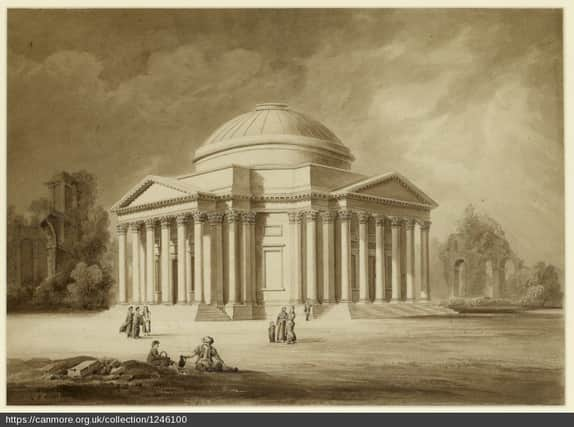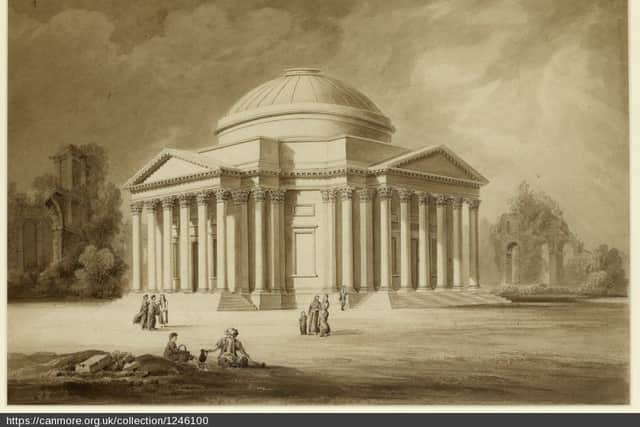William Playfair's visions for the Athens of Scotland


William Henry Playfair’s rejected plans for a monument to honour Sir Walter Scott and an underground shopping centre in Princes Street Gardens will see the light of day in the show.
Alternative plans for the Scottish National Gallery building on The Mound - which would have seen it divided by a main road - will be on display in the City Art Centre exhibition.
Advertisement
Hide AdIt will also recall Playfair’s unrealised visions to extend the New Town to the bottom of Leith Walk, a grand terrace on the slopes of Calton Hill and his proposed national monument on Calton Hill, which was notoriously never completed when funding ran out.


Architectural drawings and sketches by Playfair are accompanied by a number of paintings of 19th century Edinburgh illustrating the impact he had on the city’s landscape.
Born in 1790, Playfair was the son of the London architect James Playfair and the nephew of the mathematician and geologist John Playfair.
He was only four when his father passed away and moved north to live with his uncle when he was a teenager and is thought to have developed many of his ideas on culture, society and politics after regularly attending intellectual debates and “salons” at John Playfair’s home.
The exhibition, jointly organised by Edinburgh City Council and Edinburgh University, will deploy more than 50 images to chart his life and legacy, and recall his vision and ambition for the city.


Organisers say it will explore how Playfair “helped shape Edinburgh into the city that we see today” and chart the city’s progression from a neo-classical Englightenment city to the industrial powerhouse of the Victorian age.
Advertisement
Hide AdThe exhibition, which runs from Saturday until 25 February, will look at how his designs were intended to “expand and ornament the city”, as well comment on Edinburgh’s role in the Scottish nation and how it contributed to “upholding the State of Great Britain and the British Empire.”
It includes early visions by Playfair for some of his most celebrated projects, including Donaldson’s School for the Deaf, the New College buliding for Edinburgh University on The Mound, and the City Observatory on Calton Hill.
Advertisement
Hide AdHowever it also looks at the unbuilt or unfinished projects which “never quite managed to make the impact on the city landscape that Playfair had envisioned,” but were intended to showcase Edinburgh as a “modern metropolis.” The exhibition recalls how his vision for a New Town extension would have seen wide streets “radiating” off Leith towards new public spaces to create an “open leafy suburb.”
A shopping mall inspired by a neo-classical temple was among the other projects which failed to get off the ground, along with his both entries to the competition to design a Scott Monument. Both entries, for the west end of Princes Street and Charlotte Square were rejected in favour of George Meikle Kemp’s neo-gothic tower.
Exhibition curator Kirsten McKee, research fellow at the university, said: “William Henry Playfair is one of Scotland’s most important Georgian architects.
“His contribution to the architecture of early 19th century Edinburgh is found throughout the city – with many of his most impressive buildings and landscapes located within the Old and New Towns.
“The vision and ambition in both Playfair’s architecture and his exploitation of the city landscape aimed to place Edinburgh as a city of style and significance within the British Isles.
“His contribution to the development of Edinburgh from the neo-classical Northern Athenian city, to the rapidly industrialised Edinburgh of the Victorian agewas achieved through design processes that were nuanced in detail, and executed to an obsessive degree.
Advertisement
Hide Ad“Playfair’s role as an architect of significance in the 19th century therefore extends outside of Edinburgh, and places him within the realm o the British architectural greats of the late Georgian period.
“His work also highlights the huge influence major institutions had within the civic landscape of late Georgian Edinburgh, and the interconnectivity between these institutions during the 19th century.
Advertisement
Hide Ad“While the chosen drawings demonstrate a variety of architectural styles used during his career, the exhibition also explores how he developed his design skills through the study of historic buildings within the city.”